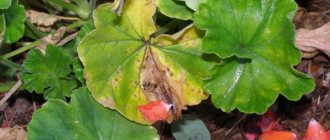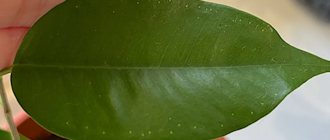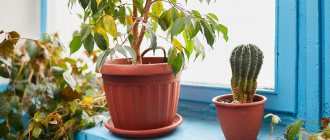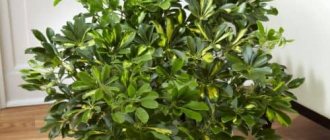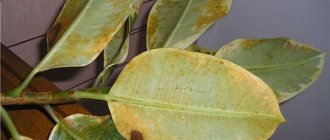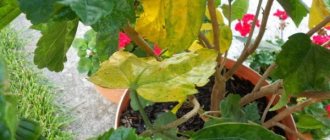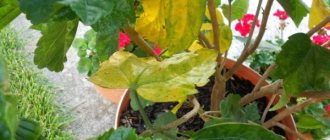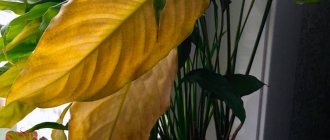On the eve of the New Year and Christmas holidays, many people buy a wonderful plant - poinsettia - to decorate their home. It’s not for nothing that the flower is called the “Christmas star” - it is in December-February that it is most decorative and decorates the apartment with splashes of bright color.
The culture is actually called the most beautiful euphorbia and it is not exactly an indoor flower. In nature, this is an evergreen shrub native to Central America, which reaches a height of 2-3 m, and its red “leaves” are not flower petals at all (the flowers of milkweed are yellow, very small and inconspicuous), but the covering leaves (bracts), which surround. Evolutionarily, plants have developed such an adaptation to attract pollinating insects.
It is precisely because of the large and bright decorative bracts, which are collected in the shape of a conventional “star”, that spurge was introduced into cultivation and received its new name (it was once called the “Mexican fire flower”), and then became a real pre-Christmas seasonal product at first in the USA, and then in the rest of the world.
Each year in the United States, approximately sixty million poinsettias are sold in the six weeks leading up to and during the winter holidays.
Today, cultivated varieties of poinsettia have been developed with other shades of bracts - yellow, pink, white, bicolor, striped, with a contrasting color “spraying” or edging - as well as dwarf forms that feel great at home.
Natural causes
If you create the necessary conditions , it will bloom for a long time, delighting you with its exotic, unique appearance, bright colors of leaves and flowers.
And after flowering, the plant begins a long period of dormancy, during which the leaves drop. This is an absolutely natural process.
If the poinsettia dropped its magnificent leaves in February or early March, then there is no reason to panic .
During this period, you need to cut the bush in half, move it to a cool room, shade it a little, and water it periodically so that the lump of earth always remains moist.
In the wintering place, the temperature should not fall below 10°C. The flower should remain in this state until mid-April, after which it will begin to gradually awaken.
With the onset of the growing season , the poinsettia needs to be transplanted into a new pot, moved closer to bright light and warmth, and active watering and fertilizing begin. Many new young shoots will sprout, but only the strongest of them (3-5 pieces) should be left.
Our article will tell you the secrets of gardeners for caring for bougainvillea at home.
Why auto-watering for indoor plants? Read the answer in our material.
What are the most useful indoor plants - find out about it at the link: https://sad-doma.net/polezno/top/samye-poleznye-komnatnye-rasteniya.html
Flower diseases
Any plant needs attention. If you forget about the flower on the windowsill, skip watering, and don’t observe the temperature regime, then one day, when you open the curtains, you can see a naked, dried plant.
- Withers after purchase. Poinsettia is usually purchased in winter during its flowering, and January-February is the period when flowering ends and leaves fall. When choosing a green pet, you need to be guided by the following rule: look not at the bracts, but at the flowers. They should be in buds, unblown.
- The plant turns black. Poinsettia is a tropical plant. Low temperatures cause the plant to freeze and the leaves to turn black. It is necessary to observe the thermal regime.
- Rust. If, upon examination of the poinsettia, leaves were found with yellow scorch and rust along the edges, then the reason is too high an air temperature and low humidity. It is important to spray the leaves in a timely manner and, if necessary, move the plant to a cooler, more comfortable place.
- Loss of elasticity. If the leaves have lost their elasticity, turgor, and began to look lifeless, then the reason lies in improper watering: there is either too much moisture or too little. In this case, you need to adjust the watering process. Poinsettias like moist, but not soggy soil. It is important to monitor the soil and water as soon as the top of the soil becomes dry. Do not let it dry out.
- If it has completely dried up and dies, how can it be revived? The steps are the same as when sending a flower to rest:
- cut the plant in half (read about when to prune poinsettia and how to do it correctly);
- put the pot in a cool, dark place;
- water no more than once a month;
- get it in 2-3 months;
- wait for new shoots.
- The plant is frozen, how to save it? Did you open the window and the flower froze and the leaves turned black? Need to:
- trim frostbitten shoots;
- put in a warm place;
- treat with zircon, a plant biostimulator.
Also, some poinsettia owners complain that it does not bloom. We wrote about what to do if such a problem occurs here.
Errors in care
The reasons for dropping leaves may be the following errors :
- unacceptable temperature difference;
- insufficient lighting;
- drying out or waterlogging of the substrate;
- air is too dry.
As you can see, the reasons are the most common. If during the growing season the plant is kept in a bright and warm room, constantly sprayed and fed, there will be no problems. But some gross mistakes can cause not only the loss of leaves, but also the death of the poinsettia .
Most of all, the poinsettia flower is afraid of the cold.
If you leave it in the cold for even a short time, it can be disastrous for the plant: first the leaves will fall off, and then the roots will die. But a short-term drought will not harm the Christmas star.
When the earthen ball dries out , yellowing and shedding of leaves may begin, but it is enough to resume regular watering, and the plant will quickly come into shape.
In addition, the delicate and capricious poinsettia reacts poorly to drafts and excessive dry air, which can also cause disease . But still, most often the culprits of leaf loss are parasitic insects.
How to Care for Poinsettias the Rest of the Year
For the rest of the spring-summer growing season, poinsettia will look like a green bush with soft, erect stems and wide, rounded green leaves - you just need to provide it with proper care, which, however, is not difficult.
Provide the plant with the brightest place in the apartment, but not in direct sunlight - lighting for poinsettia should rather be diffused; it should be shaded from direct sun.
The optimal content temperature is in the range of 16-20°C. At the same time, protect the plant from drafts or constant temperature changes - it really doesn’t like this.
Poinsettias need regular but moderate watering. In summer, water more often, add to the watering by spraying the leaves with warm, settled water. The soil in the pot should never dry out completely, but stagnation of water in the pan is also unacceptable - drain off the excess.
Once every two weeks, provide the plant with complex mineral nutrition (you can use fertilizer for cacti).
If, already during the growing season, your poinsettia's leaves begin to turn yellow or darken, dry out at the edges, droop, wither, curl or fall off, then something has gone wrong. Check for the following traumatic factors, and if so, eliminate them:
- The plant regularly lacks moisture or, on the contrary, it suffers from constant overwatering.
- The plant stands in a draft, is exposed to temperature changes or freezes.
- The plant does not have enough space; it lives in a pot that is too small.
- The plant suffers from dry air.
- The plant has been living in old, depleted soil for a long time, without receiving fertilizing.
- The plant is dark or, on the contrary, is constantly under direct scorching sunlight.
Also regularly inspect your poinsettia for diseases or pests. Gray mold on the leaves, cobwebs, rot or dry dark spots - all these are signs of the “work” of pathogenic organisms; decide on their type and take appropriate measures (fungicides or insecticides).
Pests
Spider mites are tiny red spiders that can form colonies on the undersides of leaves and envelop the plant in white webs. If this pest is detected, you should immediately wash the flower with tobacco tincture and sprinkle with ground sulfur. If these methods do not help, apply insecticides.
Scale insects and mealybugs are no less dangerous for poinsettias. These pests are capable of sucking all the juice out of it in a short time. If you notice powdery plaque or scale insect larvae, remove them mechanically, remove all traces on the leaves and stems, then treat the flower with a soapy solution and rinse with clean water at room temperature.
If the leaves continue to turn yellow and fall off after this, apply fungicides .
What diseases and pests affect the plant?
Soil salinization
Signs of a problem - the leaves become brown or yellow at the edges, dry out and crumble, and a white crust forms on the ground. Occurs due to excess mineral salts in the kidney and excessive feeding. To improve the situation, it is necessary to regularly loosen and ensure good drainage .
Twisted and curled leaves
The reason lies in the lack of the chemical element molybdenum. The acidity of the soil should be increased to pH 5.8–6.2 using special preparations, for example, feeding with Poinsettia Mix.
Enatsii
Sometimes flat growths resembling scales form on poinsettia leaves . The exact cause of this disease has not been established; it is probably caused by viruses, improper feeding or exposure to cold. You can try to avoid the problem by carefully following the rules of caring for the plant.
spotting
White spots appear on the bracts. This happens most often due to a lack of light, minerals, or sudden changes in temperature and humidity. Restoring the optimal maintenance regime allows you to get rid of the problem.
Chimeras
Young leaves have a strange shape, color and density . The cause of the disease is a spontaneous mutation in cells during cuttings. This violation is not dangerous and no measures need to be taken.
Mosaic virus
Dark and light spots form on the leaves. The cause is a viral infection caused by sucking insects. It is the vectors that need to be fought.
Unfortunately, poinsettia infected with viruses cannot be saved; it will die.
Southern late blight
Signs: fading leaves, softened and rotting roots. The disease is caused by the Phytophthor fungus, which develops in waterlogged soil. To save the flower, it is sprayed with Allet, ensure high-quality drainage and water less frequently, but at the same time abundantly.
Uneven coloring
The bracts are unevenly colored, with green color visible in places. This happens when there are sudden changes in temperature from warm to cold, for example, when ventilating a room. To avoid this problem, you should keep the flower warm when its tops begin to gain color.
Root and stem rot
Depressed dark spots appear on the stems, the roots rot and look frayed, and the shell falls away from them. The disease is caused by fungi of the genus Pythium , which develop in conditions of dampness and low acidity of the soil. It is necessary to stop watering, change some of the soil to dry and loose, and treat the plant with the fungicide Ridomil.
Sooty mushrooms
The disease manifests itself as a fungal coating on the leaves, first light, then dirty and turning black. Caused by a virus carried by whiteflies and scale insects. Plaque forms in areas where insects have left sticky marks - photosynthesis is disrupted there. The plant is washed with soapy water to remove plaque and insects are destroyed using special means.
It is better to prevent any disease than to fight it later. To preserve poinsettia and prevent it from dying, it is necessary to provide the flower with comfortable conditions and proper care, and regularly inspect it for pests and diseases.
What does a poinsettia need?
For normal development and active growth, the Christmas star needs to create conditions close to its natural habitat:
- moderate temperature (from 10 to 16°C in winter and from 17 to 25°C in summer);
- regular moderate watering;
- good lighting during the period of active growth;
- sufficient air humidity.
Why poinsettia leaves turn yellow and fall off and what to do - see the recommendations of professionals in the video below:
Poinsettia , like all beauties, is quite capricious, and its peculiarity is to bloom in the cold season, when most plants rest, making this wonderful plant simply indispensable for the home green collection.
Show a little more care - and it will paint your winter with bright red and green colors and become a real star of the Christmas and New Year holidays.
